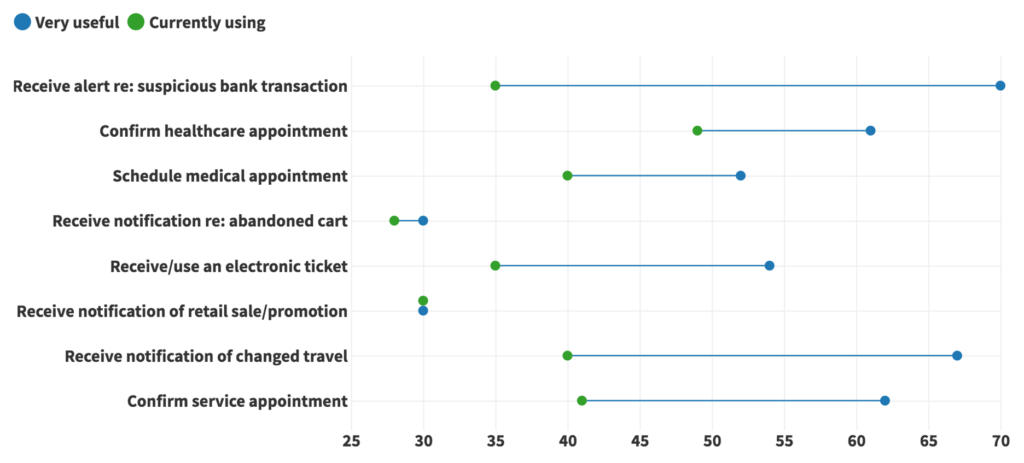If you read the last post on our recent research findings, you’ll know all about how consumers are using mobile messaging (or maybe you’ve read the whole report already?) In this second part of our mini blog series we’ll take a look at the opportunities that businesses are missing when it comes to reaching consumers in the ways they crave - we dive into the mobile messaging opportunity gap.
The most interesting part of the Sinch research is comparing what consumers say they welcome in the future versus what they currently use. The gap between those two -- what at Sinch we call the “opportunity gap” -- shows exactly where businesses should devote more attention and resources.
In banking, healthcare, travel and the service industry, consumers are looking for more mobile-based notifications and interactions. In other words, there is a large gap between what consumers do today, versus what they signal they would welcome or find useful.
In retail, the opportunity gap is small-to-non-existent. The clear message from consumers: the current level of mobile interaction in retail is enough. Retailers must proceed carefully, ensuring that mobile messaging is welcome (and be particularly wary of messaging consumers who are not yet customers).
Opportunity gap
Which types of messaging do consumers currently use; which do they find useful

Key takeaways for 2020
What does it all mean? You can find a lengthy discussion of key takeaways for executives in the full report, but the following are some important considerations to begin:
Prioritize customer value
Mobile messaging is a channel full of opportunity, but it also bears significant “permission risk.” Businesses must focus on delivering value that consumers clearly indicate they want and welcome, rather than using customer data to sell more or promote. Those that focus on the latter risk that their customers may put them on mobile mute, and once a company has lost permission to send messages, it’s very hard to re-earn trust.
Explore unmet needs
In what areas are your customers signaling they want more? Want less? The Sinch research clearly shows “imminent notifications” have high value for consumers -- or messages that remind of upcoming dates or services, or notify of time-critical information. Keep in mind, however, that some offerings such as personalized video prove extremely valuable to consumers and enterprises alike, as they are easier to consume and have significant engagement rates. Though personalized video is currently under-utilised, we expect this will change in 2020.
Prepare for the future
RCS is breaking ground in countries like UK, US, France, Japan and more, but businesses can use innovative opportunities in mobile engagement today on a plethora of global and regional specific channels. Above we mentioned personalized video -- among the most exciting opportunities most businesses are not yet using, even though it is available on MMS today in the US for example. Some other applications to consider: using messaging for real-time translation, mining company “chats” for consumer intelligence and using this to feed chatbots for more routine tasks and initial customer service.
If you want to read the full research report, including data about chatbots, privacy and scenario testing, you'll find it here.



